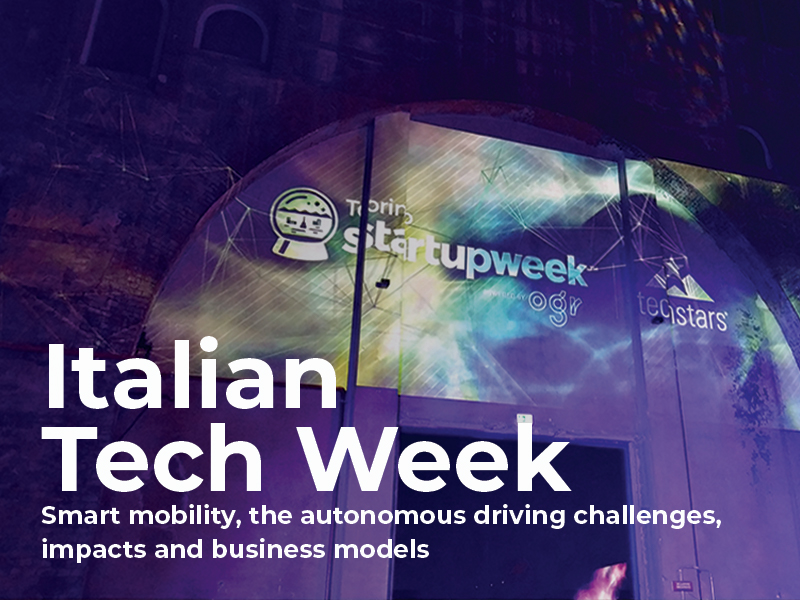Mobility Ecosystem – The Carmaker’s Perspective
The OGR main room was the suitable background for the afternoon session of the Italian Tech Week on 27th June 2019 deals about the smart mobility, the autonomous driving challenges, impacts and business models. Automotive industries play a basic role in the future scenario definition and the mobility ecosystem is based on solid aspects that guide the carmakers’ perspective. The key trends for global automotive industry are:
- Electrification
- Autonomous Driving
- Connectivity
- Shared Mobility
The tendency of global long-term passenger vehicle sales reflects a clear view where less than 10 milions of electric cars will be sale in 2025, 30 million in 2035 and more than 40 million in 2040. 120 EVs new models are expected to be launched annually in the next few years. In this field, the battery pack architecture will be a driver for the design, benchmarked native electric vehicles offers 25% larger battery packs relative to vehicles’ body-in-white volume. Of 11 benchmarked electric vehicles, the 3 that offer multiple-range options are native electric vehicles. In 2018 18% of global EV sales were from 6 Chinese cities. In Europe, Norway is an example: EVs soared to 32% of car sold in 2018, from 11% in 2014. Both production and consumer demand are rising fast; design and production improvements could move electric vehicles toward profitability and reducing the need for subsidies.
Development steps to reach the fully automated driving, according to SAE definition [ https://www.sae.org/news/press-room/2018/12/sae-international-releases-updated-visual-chart-for-its-%E2%80%9Clevels-of-driving-automation%E2%80%9D-standard-for-self-driving-vehicles ], are 5. Nowadays, level 2 is legally permissible and already offered by OEMs, more than one control functionality is automated under certain conditions. Driver expected to take care of all remaining aspects of the dynamic driving task. Analysts expect the commercial deployment of fully self-driving cars in cities to start by 2025. By 2035 nearly one in four new cars sold globally will be fully autonomous. AVs global revenues in urban areas could reach USD 1.6 trillion in 2030 (>2 x 2017 cumulated Ford, GM, Toyota and Volkswagen revenues). The legal framework with regulatory approval on agenda of many jurisdictions will move together with social impact for drivers where younger generation will be increasingly receptive. Finally, once mass production will start with a specific purpose design of AV, cost for component will decline. Autonomous driving promises to reshape the very nature of how people experience mobility.
Connectivity will be a source for new automotive revenues. Recurring revenues will be $ >100 billion from data connectivity services, including apps, navigation, entertainment, remote services and software upgrades. After-market spending will be higher for annual maintenance for shared vehicles but 20-30% lower for maintenance spending on electric powertrains. Vehicle unit sales ≈50% of value chain, total sales expected to decline once AV become widespread. Connected cars will become the nodes of vast information networks which will open a new dimension of value for drivers, auto manufactures and innovative service providers.
A competitive landscape is defined by shared mobility. In recent years, more and more car manufacturers have invested in car-sharing, seeing this service as one of the strategic pillars of their future business (Daimler AG and BMW with Share Now, General Motors with Maven). USD 55 bn has been invested in the last seven years (United States is a USD 30 bn, still growing, market). On top of that, there are many partnerships in place where OEMs tried to play a role in this segment, even without fully investing (FCA and Eni with Enjoy). Next to OEMs, multi brand car-sharing companies are imposing their new business model based on offering a service of car sharing with a driver which is changing the mobility-as-a-service (MaaS) landscape (Uber, lyft, DiDi, Lynk&Co). The role of electrification of car-sharing is a new trend for car sharing industry. The Governments are putting regulations and incentives in place to increase EV usage overall to reduce emission. Car-sharing fleets generally have high interest in adding EV because it often allows them to gain access to special parking permits, centre of cities or special governmental subsides. From an operational perspective, governments, municipalities and utility providers need to invest in large scale charging infrastructure coverage. Aggregation & integration of the services will become crucial for larger cities that are reaching a state of saturation with several different car-sharing providers. The increase in competition will create more incentives to partner up and create synergies. MaaS means fully integrated mobility, as well as integrated public transit in even the largest, most bustling cities. To achieve the state-of-the-art experience, companies are now focusing in shifting their attention from high population density cities to low population density ones. The goal is a seamless user experience which could increase the number of people forgoing vehicle ownership because MaaS offers the same convenience and freedom.


Lorenzo, ERRE GES


